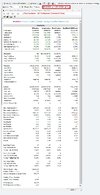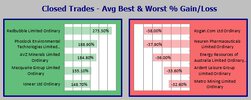- Joined
- 28 December 2013
- Posts
- 6,392
- Reactions
- 24,319
Initial results
Based on the backtest results the "Dual Breakout Strategy" produced impressive returns with a good reward for the risk taken. The win rate of 38.95% is relatively low. However, this is expected for breakout strategies which cut losses quickly but let winners run. The max trade drawdown of -45% and max system drawdown of -14% seem reasonable for this type of strategy. A solid profit factor of 1.62 and a high expectancy of $411 per trade indicate good upside capture potential. The positive K-ratio shows more large winning trades than losing trades.
On the flip side
The recovery factor of 3.68 suggests the system is adaptable to varying market conditions. The Ulcer Index of 6.25 indicates moderate drawdown pain over time.
In summary
The backtest shows promising reward potential for a breakout trend-following approach. There is likely room for improvement in win rate and drawdown control with parameter tuning. Overall, the strategy exhibits positive expectancy and has demonstrated strong historical results. The use of adaptive analysis provides an edge in trend detection across changing market environments. With robust risk management, the system could produce reliable returns from capturing emerging uptrends.

Skate.
Based on the backtest results the "Dual Breakout Strategy" produced impressive returns with a good reward for the risk taken. The win rate of 38.95% is relatively low. However, this is expected for breakout strategies which cut losses quickly but let winners run. The max trade drawdown of -45% and max system drawdown of -14% seem reasonable for this type of strategy. A solid profit factor of 1.62 and a high expectancy of $411 per trade indicate good upside capture potential. The positive K-ratio shows more large winning trades than losing trades.
On the flip side
The recovery factor of 3.68 suggests the system is adaptable to varying market conditions. The Ulcer Index of 6.25 indicates moderate drawdown pain over time.
In summary
The backtest shows promising reward potential for a breakout trend-following approach. There is likely room for improvement in win rate and drawdown control with parameter tuning. Overall, the strategy exhibits positive expectancy and has demonstrated strong historical results. The use of adaptive analysis provides an edge in trend detection across changing market environments. With robust risk management, the system could produce reliable returns from capturing emerging uptrends.

Skate.









